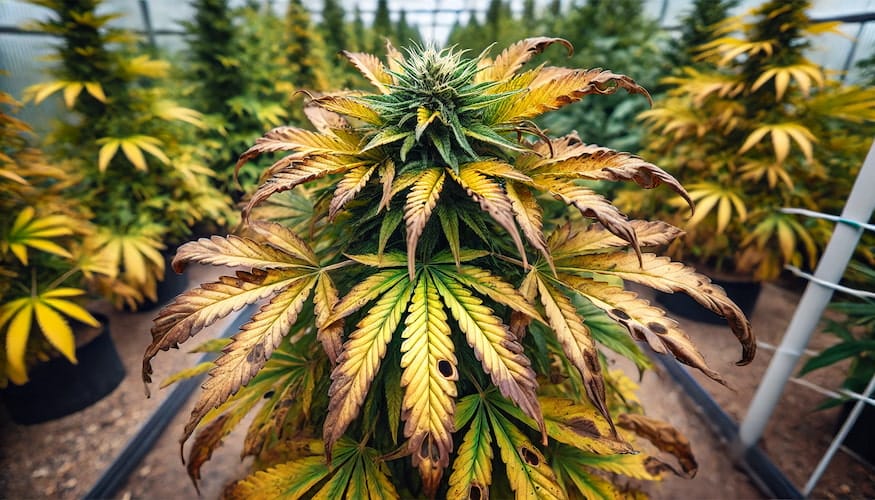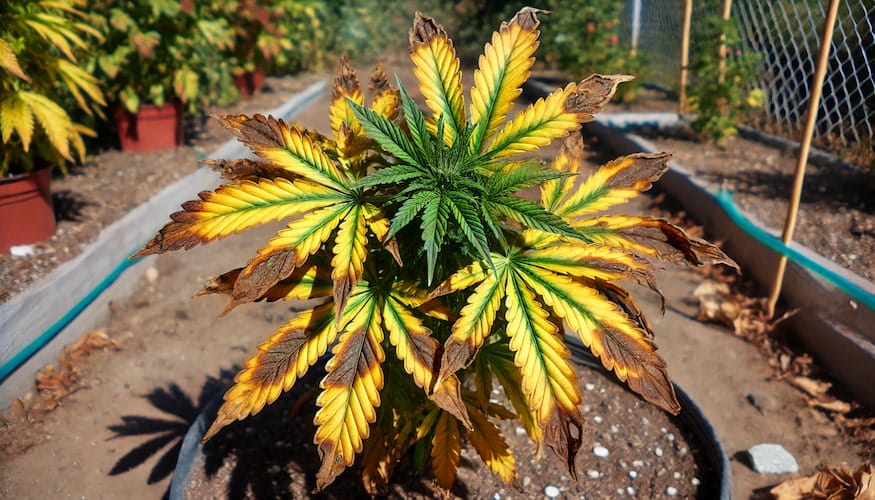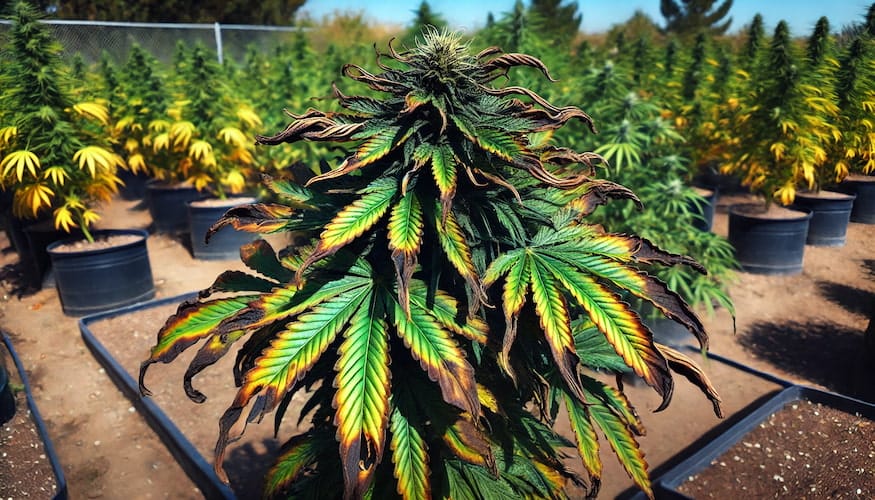Potassium Deficiency and Toxicity in Cannabis Plants

Cannabis cultivation is an intricate art that requires a deep understanding of plant nutrition. One of the essential nutrients cannabis plants need to thrive is potassium (K), an element that plays a critical role in growth, metabolism, and overall plant health. While potassium is vital, its levels must be carefully balanced. Both potassium deficiency and toxicity can wreak havoc on cannabis crops, leading to stunted growth, reduced yields, and other serious issues.
In this comprehensive guide, we’ll delve into the signs, causes, and remedies for potassium deficiency and toxicity in cannabis plants. We’ll also explore the role potassium plays in the plant’s life cycle, offering tips on how to maintain optimal levels for healthy, robust plants.
The Role of Potassium in Cannabis
Potassium is a macronutrient, meaning cannabis plants need it in relatively large quantities compared to micronutrients like zinc or manganese. It’s classified as a primary nutrient alongside nitrogen (N) and phosphorus (P), forming the familiar N-P-K ratio found on most fertilizer labels.
Key Functions of Potassium in Cannabis:
- Enzyme Activation: Potassium activates enzymes crucial for photosynthesis, protein synthesis, and carbohydrate metabolism.
- Water Regulation: Potassium regulates the opening and closing of stomata—small pores on the leaves that allow gas exchange. This helps plants maintain water balance, especially during drought or high heat conditions.
- Sugar Transport: Potassium is involved in the translocation of sugars, meaning it helps move carbohydrates produced during photosynthesis from the leaves to other parts of the plant, such as roots and buds.
- Cell Strength: It plays a role in strengthening cell walls, leading to more resilient plants that are less susceptible to diseases.
- Stress Tolerance: Adequate potassium levels help plants cope with environmental stresses, including cold, heat, drought, and disease.
Given the importance of potassium, maintaining the right balance is crucial for growing healthy cannabis plants. Too little, and your plants will suffer from potassium deficiency; too much, and you may face potassium toxicity. Let’s explore these two extremes in detail.

Potassium Deficiency in Cannabis
Potassium deficiency occurs when plants don’t have access to enough potassium, either due to inadequate levels in the soil or growing medium or because environmental factors prevent the plant from absorbing it properly.
Symptoms of Potassium Deficiency
Identifying potassium deficiency early is critical for preventing long-term damage to your cannabis plants. Here are the common signs:
- Yellowing of Leaves (Chlorosis): One of the earliest signs of potassium deficiency is chlorosis, particularly in older leaves. The leaves start to yellow from the edges inward, creating a distinct pattern.
- Leaf Burn and Necrosis: As the deficiency progresses, the yellow edges of the leaves will begin to brown and curl, ultimately leading to necrosis (death) of the tissue. This is often referred to as “leaf burn.”
- Weak Stems and Branches: Potassium-deficient plants tend to have weaker stems and branches, which may result in poor support for buds and a higher likelihood of breakage.
- Slowed Growth: Potassium plays a vital role in cell division and growth. A deficiency often results in stunted growth, particularly during the flowering phase, leading to smaller, less developed buds.
- Reduced Flowering and Yield: Without adequate potassium, cannabis plants will struggle to produce large, dense flowers. This deficiency can directly reduce yield and potency.
- Weak Stress Response: Since potassium helps plants cope with environmental stress, a deficiency will make them more susceptible to diseases, pests, and environmental fluctuations.
Causes of Potassium Deficiency
- Poor Soil Quality: The most common cause of potassium deficiency is poor-quality soil or growing media that lack sufficient potassium.
- pH Imbalance: Cannabis plants can only absorb potassium within a specific pH range. For soil, this is generally between 6.0 and 7.0, and for hydroponics, between 5.5 and 6.5. If the pH is too low or too high, the plant’s ability to absorb potassium will be impaired, even if there’s plenty of potassium in the growing medium.
- Nutrient Lockout: Potassium can be locked out of the soil due to excess levels of other nutrients, particularly calcium, magnesium, or sodium, which compete for uptake in the roots.
- Watering Issues: Overwatering can wash away potassium from the soil while underwatering can prevent plants from taking up enough nutrients.
- Cold Temperatures: Low temperatures can slow the plant’s metabolism and its ability to absorb nutrients, including potassium.
How To Fix Potassium Deficiency
- Check pH Levels: The first step in correcting potassium deficiency is to ensure that the pH of your growing medium is within the optimal range. For soil, aim for a pH of 6.0–7.0, and for hydroponics, maintain a pH of 5.5–6.5. Adjust the pH if necessary using pH up or pH down solutions.
- Use Potassium-Rich Fertilizers: If the deficiency is due to a lack of potassium in the soil, use fertilizers rich in potassium. Look for products with a higher K value in the N-P-K ratio. For example, a 0-0-60 fertilizer is pure potassium.
- Flush the Growing Medium: If nutrient lockout is the issue, flushing the soil with pH-balanced water can help remove excess salts and allow the plant to access potassium.
- Foliar Feeding: In severe cases, foliar feeding with a potassium solution can provide immediate relief. This allows the plant to absorb potassium directly through its leaves.
- Address Environmental Factors: Ensure that your plants are in the right temperature range and that watering practices are consistent and appropriate for the growing medium.

Potassium Toxicity in Cannabis
While potassium is an essential nutrient, too much of it can be harmful. Potassium toxicity occurs when plants are exposed to excessive levels of potassium, often due to over-fertilization or imbalances in the nutrient solution.
Symptoms of Potassium Toxicity
- Nutrient Lockout: The most significant issue with potassium toxicity is that it can lead to nutrient lockout, particularly of calcium, magnesium, and other micronutrients like iron. This can result in secondary deficiencies that are more damaging than the excess potassium itself.
- Burnt Leaf Tips: One of the first signs of potassium toxicity is burnt leaf tips, where the edges of the leaves turn brown and crispy. This is often mistaken for nutrient burn caused by over-fertilizing.
- Interveinal Chlorosis: Magnesium and calcium deficiencies, caused by potassium toxicity, can lead to yellowing between the veins of the leaves, giving them a marbled appearance.
- Stunted Growth: Like potassium deficiency, toxicity can stunt the plant’s growth, particularly during the flowering stage. Plants may appear healthy at first but will produce smaller buds and less resin.
- Cracking and Brittle Stems: In severe cases, excessive potassium can lead to brittle stems that crack easily, making the plant more susceptible to damage and disease.
Causes of Potassium Toxicity
- Over-Fertilization: The most common cause of potassium toxicity is the overuse of potassium-rich fertilizers. When growers try to compensate for perceived deficiencies, they may inadvertently create toxic conditions for the plant.
- Imbalanced N-P-K Ratios: Fertilizers with an unbalanced N-P-K ratio can lead to an excess of potassium in the growing medium, especially if they are used without regard to the plant’s actual needs.
- Hard Water: In some cases, hard water with high levels of minerals like potassium can contribute to toxicity, especially if the water is not filtered or adjusted before use.
- Improper Nutrient Solutions: In hydroponics or soilless setups, improper mixing of nutrient solutions can lead to an excess of potassium. Since these systems rely entirely on the grower to supply nutrients, errors in formulation can have serious consequences.
How To Fix Potassium Toxicity
- Flush the Growing Medium: The first step in correcting potassium toxicity is to flush the soil or growing medium with pH-balanced water. This helps remove excess potassium and restore balance to the nutrient levels.
- Adjust Nutrient Ratios: After flushing, reevaluate your nutrient regimen. Use a balanced fertilizer that provides appropriate amounts of nitrogen, phosphorus, and potassium (N-P-K). Avoid over-applying potassium-heavy fertilizers.
- Monitor for Secondary Deficiencies: Since potassium toxicity often causes deficiencies in calcium, magnesium, and other micronutrients, you may need to supplement these nutrients once the potassium levels are corrected. Consider using a calcium-magnesium supplement (Cal-Mag) to address any deficiencies.
- Test Water Quality: If hard water is contributing to potassium toxicity, consider using a water filtration system or switch to distilled or reverse osmosis (RO) water. This will help you control the levels of minerals in your water supply.
Preventing Potassium Imbalances in Cannabis
The best way to avoid the problems associated with potassium deficiency and toxicity is to maintain a balanced nutrient regimen and monitor your plants closely. Here are some tips to help prevent potassium imbalances:
- Use Balanced Fertilizers: Choose fertilizers with an appropriate N-P-K ratio for your plant’s stage of growth. During the vegetative phase, a higher nitrogen content (e.g., 3-1-2) is generally recommended. In the flowering phase, switch to a bloom fertilizer with higher phosphorus and potassium content (e.g., 1-3-2). Avoid fertilizers with excessive potassium concentrations unless your plants specifically require them.
- Regular pH Testing: Consistently test the pH of your soil, water, and nutrient solution. Keeping the pH within the optimal range ensures that your plants can effectively absorb potassium and other essential nutrients. Regular pH testing can prevent both potassium deficiency and toxicity by ensuring that nutrients remain accessible.
- Monitor Watering Practices: Overwatering can leach potassium out of the soil, while underwatering can stress plants and prevent proper nutrient uptake. Strive for consistent, appropriate watering practices based on the growing medium and environmental conditions.
- Use Quality Growing Mediums: Invest in high-quality soils or soilless mixes that are well-drained and rich in essential nutrients, including potassium. In hydroponic setups, ensure your nutrient solution is well-balanced and formulated for the specific needs of cannabis plants.
- Watch for Early Signs: Regularly inspect your plants for signs of nutrient imbalances. Catching potassium deficiencies or toxicities early can prevent them from escalating into larger problems that harm your harvest. Pay attention to leaf color, growth patterns, and overall plant vigor.
- Flush When Needed: If you suspect a nutrient imbalance, flushing your plants with pH-balanced water can help reset the growing medium and remove excess salts. Flushing is particularly effective for both potassium toxicity and nutrient lockout situations, as it clears out harmful accumulations in the soil or growing medium.
- Consider Organic Amendments: Organic amendments like wood ash, kelp meal, and compost can provide potassium naturally, ensuring a slow, steady release of nutrients. These amendments are less likely to cause nutrient imbalances compared to synthetic fertilizers, as they release nutrients gradually over time.
Potassium and Cannabis: A Delicate Balance
The relationship between cannabis plants and potassium is a delicate one. While this essential nutrient plays a vital role in the health and productivity of your plants, too much or too little can cause serious problems. Achieving the right balance requires attention to soil health, pH levels, and nutrient ratios.
Growers must be proactive in monitoring their plants for signs of potassium deficiency or toxicity. Early intervention can prevent long-term damage, ensuring that your cannabis plants stay healthy and vigorous throughout their life cycle. By understanding the role of potassium in cannabis growth, you’ll be better equipped to manage nutrient levels and maximize your yields.
Common Questions about Potassium Deficiency and Toxicity in Cannabis
1. What is the optimal potassium range for cannabis plants?
The optimal potassium range for cannabis plants varies depending on the stage of growth. During the vegetative phase, potassium levels should be moderate, while in the flowering phase, cannabis requires a higher potassium concentration to support bud formation. Keeping the pH between 6.0 and 7.0 for soil and 5.5 to 6.5 for hydroponics ensures that potassium remains available for uptake.
2. Can potassium deficiency stunt cannabis growth?
Yes, potassium deficiency can lead to stunted growth, particularly during the flowering phase. Cannabis plants rely on potassium for healthy cell division and bud development. A deficiency can reduce the size and density of buds, significantly affecting the overall yield.
3. How does potassium toxicity cause nutrient lockout?
Potassium toxicity can prevent cannabis plants from absorbing essential secondary nutrients like calcium and magnesium. This occurs because high potassium levels interfere with the plant’s uptake of other nutrients, leading to deficiencies that may cause additional stress to the plant, such as weakened stems or poor bud development.
4. Can potassium be added to cannabis plants through foliar feeding?
Yes, foliar feeding is an effective way to provide potassium to cannabis plants, especially in the short term. This method involves spraying a potassium solution directly onto the leaves, allowing the plant to absorb the nutrient through its foliage. Foliar feeding is particularly useful when plants show signs of severe deficiency and need immediate relief.
5. How often should I flush my cannabis plants to prevent potassium toxicity?
Flushing should only be done when necessary, such as when you suspect nutrient lockout or toxicity. Overflushing can wash away beneficial nutrients and harm your plants. Typically, a flush is recommended before switching from the vegetative to the flowering phase and again if signs of toxicity are present. Always follow up with a balanced nutrient solution to restore any essential nutrients lost during the flush.
6. Can potassium toxicity kill cannabis plants?
While potassium toxicity alone is unlikely to kill cannabis plants, it can severely harm their growth and productivity by causing nutrient lockout and secondary deficiencies. If left untreated, the resulting nutrient imbalances could lead to poor bud development, stunted growth, and increased susceptibility to diseases and pests, potentially compromising your entire crop.
Conclusion
Potassium is one of the essential nutrients cannabis plants need to thrive, but like with all nutrients, balance is key. Understanding the signs, causes, and remedies for both potassium deficiency and toxicity is crucial for any successful cannabis grower. Potassium plays a central role in photosynthesis, water regulation, stress tolerance, and sugar transportation, making it indispensable for cannabis growth.
Potassium deficiency often manifests in the form of yellowing leaves, necrosis, and reduced flowering, while toxicity leads to burnt tips, nutrient lockout, and brittle stems. Correcting these issues involves adjusting pH levels, flushing the growing medium, and ensuring a balanced nutrient regimen.
By maintaining proper potassium levels, growers can ensure robust, healthy plants that produce high-quality, dense flowers. Through consistent monitoring, balanced feeding, and environmental management, potassium imbalances can be avoided, leading to a more bountiful and potent cannabis harvest.
Now that you know all about potassium for cannabis plants, shop the collection of regular, feminized, and autoflower cannabis seeds and clones at Seeds Here Now.
Subscribe to our newsletter
Your dream garden is a subscription away! Join our email list and enter our Monthly Seed Giveaway. Imagine the possibilities each month as you await your chance to win.
By clicking the "Subscribe now" button, I agree and accept the privacy policy of Search Engine Journal.
Suggested Articles
;)
;)
;)
James Bean is the founder of Seeds Here Now, a company dedicated to providing high-quality, organic and heirloom seeds. With a passion for sustainability and self-sufficiency, James has been committed to educating and empowering individuals to grow their own no matter where they live. Through Seeds Here Now, James has created a thriving community of gardeners and farmers who share his vision for a more sustainable and self-sufficient future.




 03 Jul 2025
03 Jul 2025  10 min read
10 min read


 September 05, 2024
September 05, 2024 


RESPONSES (0)
No responses yet. Be the first to respond!